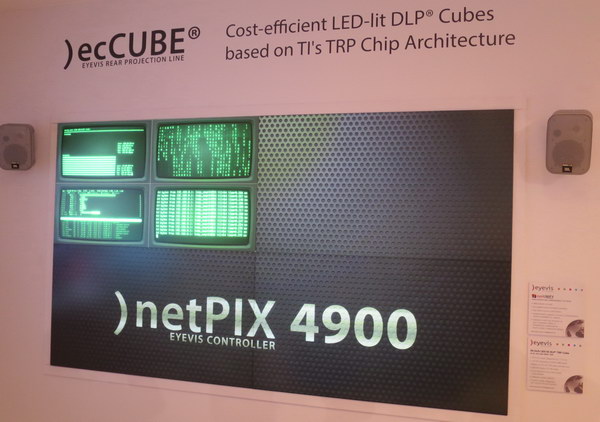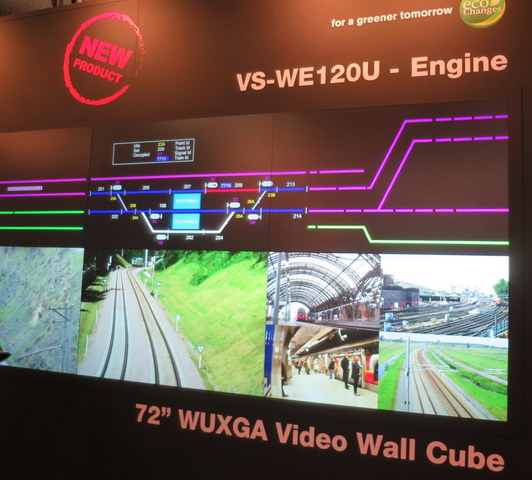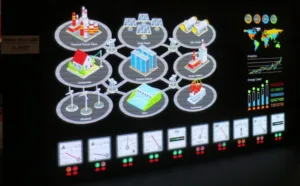Several years ago, LEDs replaced lamps in rear projection videowall cubes, which serves the command and control market. Lamp-based units have not been available and all vendors have offered replacement light engines so system operators could upgrade existing walls from lamps to LEDs. The main advantage of LEDs over lamps was their very long life in the low-brightness cube application, reducing or eliminating maintenance on the mission critical control room videowalls. Recently the technology in this market has been stable – single panel DLP projectors with LED illumination have made up essentially 100% of this small but profitable market.
At ISE 2017, I visited four cube vendors, Mitsubishi, Barco, Eyevis and Delta. I’d expected to see only LED illumination, but two companies have shown different light source technologies coupled to their single panel DLP projectors. At the show, Delta showed cubes with laser-phosphor illumination, introducing a new 4K model, and Barco introduced cubes with RGB laser illumination.
The Barco ODL-721 is a RGB laser-based cube. This product was not introduced at ISE since they had been shown before in China in August, 2016, but this is the first time I had seen them. The cube is a 70” diagonal system with a FHD (1920 x 1080) optical engine. Barco claims multiple advantages for RGB lasers over LEDs as a rear-projection cube illumination source, including 2x higher brightness, as can be seen in the photo, more accurate colors with better contrast, 3x lower energy consumption (7.5 vs 2.3 lumens/watt), and a longer lifetime of 100K hours. If run at 2x the brightness of LED cubes, Barco says there is still a 25% energy savings. The higher brightness also allows the use of wider viewing angle screens. Not related to the lasers, the ODL-721 has a 7-axis motorized positioner to simplify installation. While the ODL-721 is serviced from the rear, Barco also makes the ODLF-721 which can be serviced from the front.
 Two Barco RP cubes to show the 2x brightness increase of the one with RGB lasers (top) vs RGB LEDs (bottom).
Two Barco RP cubes to show the 2x brightness increase of the one with RGB lasers (top) vs RGB LEDs (bottom).
Eyevis was showing the world’s first rear-projection cube based on a DLP TRP imager. This family of cubes was announced last June, shown previously in September and is shipping now. There are two models in the family, the 50” EC-50-LHD-TRP-WVF and the 60” EC-60-LHD-TRP-WVF. Both cubes are based on a 0.47” FHD (1920 x 1080) TRP DLP imager. The 50” cube produces a brightness of 550 nits while the 60” cube produces 420 nits, both at maximum brightness. In the normal operational mode, the two produce 420 and 300 nits respectively. The LEDs are good for >60,000 hours in the normal operational mode and up to 90,000 hours with reduced power and brightness. The cubes are designed to stack with ≤0.3mm gap between images. Eyevis says these cubes are the lowest power consumption of any of their cubes and are sold at an “entry-level price.” Eyevis was also showing a 0.9mm pitch direct view LED display in their booth. This product was developed by Unilumin, and will be discussed in another article in this issue.
 2 x 2 array of Eyevis TRP RP Cubes at ISE.
2 x 2 array of Eyevis TRP RP Cubes at ISE.
Mitsubishi introduced a new cube, the 72” WXGA (1920 x 1200) model VS-WE120U and a new rear projection screen for cubes, the SC70HE130L. This new cube uses a conventional RGB LED light source, the Mitsubishi rep told me it was the first cube on the market that could achieve 100,000 lifetime at full brightness.
 A 2½ wide and 2 high portion of the Mitsubishi display wall made of VS-72WE120U cubes.
A 2½ wide and 2 high portion of the Mitsubishi display wall made of VS-72WE120U cubes.
Mitsubishi was also showing an experimental direct view LED array that would target control room applications. The Mitsubishi rep said he expected the 1.5mm pitch array to be introduced by the end of the year. He added that the product represents a major development effort and the company wanted to ensure there were no problems with the system, which also includes a 100,000 hour lifetime, before the introduction. He said it would be significantly more expensive than a cube array but be able to produce a much higher brightness, albeit at a lower resolution. The Mitsubishi goal with this unit is to expand the control room market, not replace cubes with LED displays.
Mitsubishi direct view LED video wall targeting expanded control room markets.
Delta also was showing it’s cubes at ISE. The ones on display were both based on a laser-phosphor light source, not pure laser like Barco or pure LED like Eyevis or Mitsubishi. Two versions of the cube were on display, including the newly introduced 70” 4K UHD (3840 x 2160) unit plus a FHD (1920 x 1080) unit. The new 70” unit produces 2400 lumens output and has an extra slim form factor with a 560mm depth. While full specs are not available on the 70” 4K cube, on a similar FHD 70” cube with a laser-phosphor light source, the lifetime was 100,000 hours in eco mode, 80,000 hours in normal mode and 60,000 hours in bright mode. Besides the 4K and FHD laser-phosphor cubes, Delta makes UXGA (1600 x 1200) cubes with a laser-phosphor source.
 A 3 x 2 array of Delta’s 4K laser-phosphor cubes.
A 3 x 2 array of Delta’s 4K laser-phosphor cubes.
Vivitek is a Delta brand and had their own booth at ISE. Their front projection systems will be covered in another article in this issue. (Other Projectors at ISE) –Matthew Brennesholtz

